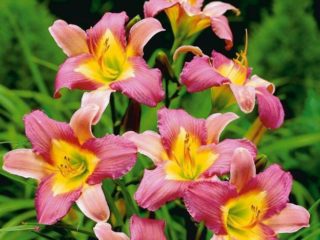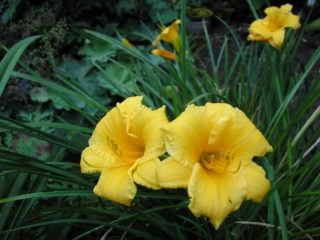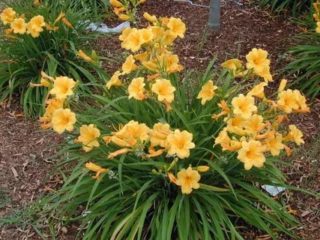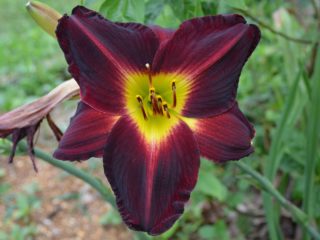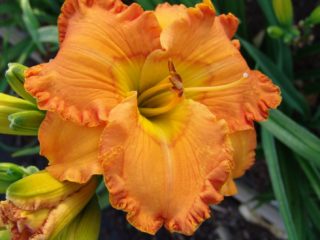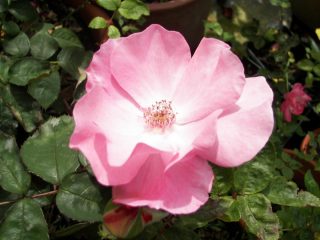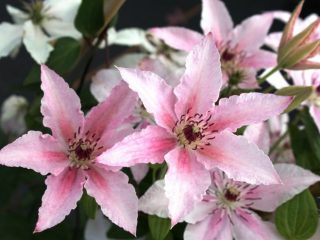Content
Daylilies are called a gift for a lazy gardener - planted and forgotten. These plants differ from other decorative flowers in their high adaptability and hardiness to habitat conditions. But if there is a desire for these flowers to please the eye with their unique and sophisticated beauty, and not just grow as it happens, you need to take care of them. Daylily Frans Hals has its own characteristics and rules for how to grow it.
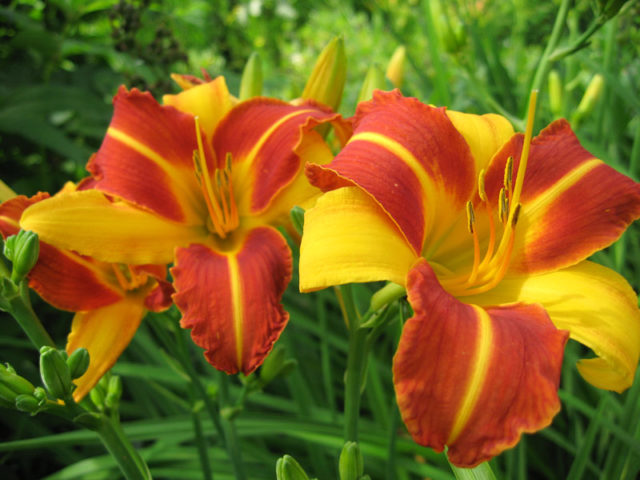
A bright, cheerful flower, the center and main decoration of any landscape composition
Description of daylily Frans Hals
It got its name from the famous Dutch painter of the 17th century Frans Hals. He was a painter predominantly of the portrait genre, but he became famous for his love to paint his paintings in a color scheme that was very close to the color of a flower. Released in 1955.
Frans Hals stands out for erect, tall arrows, 40-60 cm long. It is on them that buds grow in large numbers, from which large, bright and funnel-shaped flowers with a diameter of about 6-15 cm subsequently open. Their color is contrasting, two-colored. The upper three petals have a deep scarlet (or red-orange, terracotta, brick) color with a light vein in the middle, the lower ones are dazzling yellow. They look like 2 triangles of different colors overlapping each other. The flowers of the daylily Frans Hals are collected in several pieces per inflorescence.
The flower opens its buds from July to September. It emits a subtle delicate aroma. The narrow, dark green leaves that form the bush of the plant grow up to 1 m in height. They are xiphoid and gracefully droop to the ground.
Linear Frans Hals has excellent decorative properties, high resistance to external (negative) conditions, abundant bud formation. It perfectly tolerates all the vagaries of the weather: coolness, humidity, rain. Also, he is not in danger when there are hot dry days, which is detrimental to many other flowers.
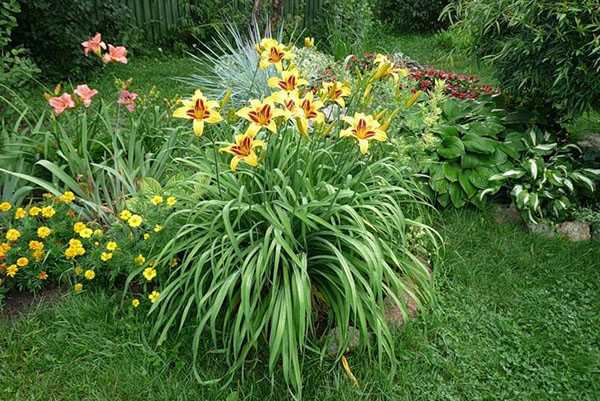
The plant has not only beautiful flowers, but also greenery.
Daylily hybrid Frans Hals in landscape design
Daylily Frans Hals is found in almost any garden. This flower can be used in any landscape compositions. It is beautiful, effective and noticeable from afar. The bush of the plant is of the correct, beautiful shape, looks great as a tapeworm.
But in combination with other plants, the daylily Frans Hals is no less beautiful. It is good to grow it in a rose garden. During the period when roses are resting before their re-flowering, the daylily becomes the main decoration of the place. Thanks to the continuous formation and flowering of buds, it maintains its temporarily subsided beauty, allows roses to prepare for a new flowering.
Daylily Frans Hals is good to plant together with greens, for example hosts. This plant has spectacular foliage that quickly grows into entire plantations and becomes a wonderful backdrop for other flowers. The bright, expressive buds of the Frans Hals daylily look harmoniously combined with the green and white graphics of the hosta leaves.
Daylily foliage is also very beautiful and expressive. Therefore, when it fades, the remaining bushes harmoniously complement other ornamental greenery.
Daylilies Frans Hals are especially good in combination with conifers (thuja, juniper, cedar, spruce). There is something in them that emphasizes the beauty of each other. Daylily can be planted separately, with tapeworm. This will enhance the beauty of the bush and draw attention to the garden.
There is another popular spectacular method of planting daylilies by Frans Hals - this is a group. Moreover, daylilies of different varieties look very impressive, for example, in the same color scheme, and one, planted together. A large number of bright sunny flowers create an incredibly eye-catching effect, which is enhanced by planting flowers of other species, but in the same color scheme, next to each other.
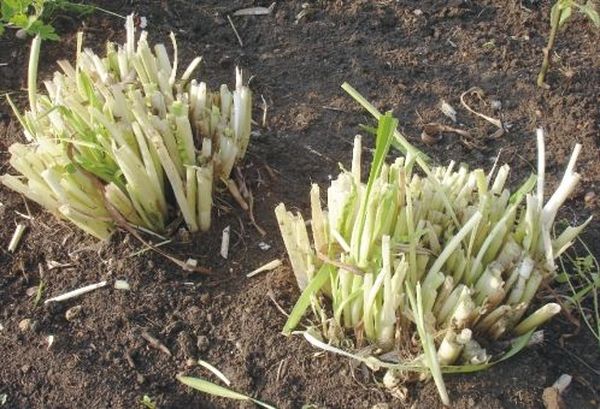
With the onset of frost, the leaves should be cut by 5-10 cm
Daylily Frans Hals winter hardiness
Daylily Frans Hals is a frost-resistant perennial plant. It is hardy and unpretentious. Does not require special warming of rhizomes for the winter. It is enough not to cut off the leaves of the bush with the onset of winter, they will serve as a good shelter for the whole winter. More thorough measures for warming are taken only for newly planted plants that have not yet sufficiently adapted to the external environment.
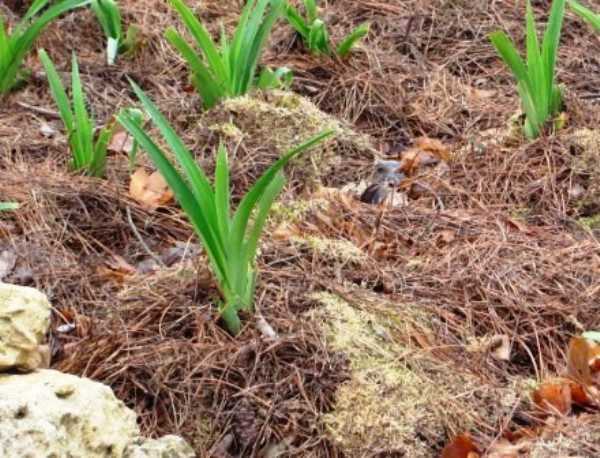
Before winter, the plant is mulched and pruned.
Planting and caring for a daylily Frans Hals
The Frans Hals daylily is widely believed to be ideal for the lazy gardener. But this flower, like any ornamental plant, needs proper care. Only in this case will it serve as a decoration for the garden landscape. With age, the Frans Hals daylily bush will become more magnificent, the flowers are brighter and larger.
Selection and preparation of the landing site
Daylily Frans Hals loves the sun. In order for it to have good buds, to bloom beautifully, you need to plant it in a well-lit place. But they can grow in light partial shade. Daylily Frans Hals takes root best on loose, drained and fertilized soils. This flower does not like stagnant water. If it has to be planted in a cold, rainy region, then it is best placed on embankments or high ground so that the roots do not rot.
In warmer regions, planting should be completely different. It is unacceptable to plant the Frans Hals daylily in flower beds, above the soil level. The roots of the flower are rather superficial and can simply overheat. The plant will give small bushes, flowers.
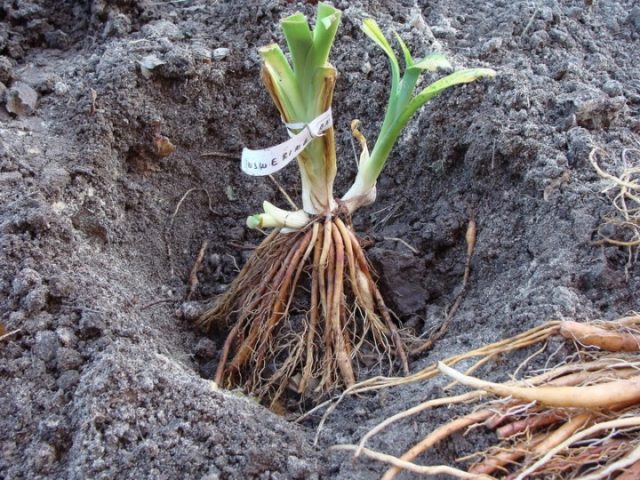
Before planting, you need to dig a hole 30 cm deep
Landing rules
If the daylily Frans Hals was purchased by mail, then such roots can be damaged, dehydrated. They need to be soaked in water with fertilizer and growth stimulant for several hours. If the daylily is dug, divided and planted in place, in this case, the roots need to be dried a little in the shade and damaged areas and partially greens removed. It will be easier for these roots to feed the rest of the leaves.
Daylily Frans Hals can be transplanted at any stage of its growth. In summer, the extracted roots must be soaked in a solution with fungicides, since at this time harmful fungi are actively developing in the soil, they develop spores.
You need to plant a daylily as follows:
- dig a hole;
- form a small cone-shaped embankment at its bottom;
- place the roots of the plant around this hill so that each root is in contact with the soil;
- sprinkle everything with earth;
- water well;
- finally fall asleep.
After planting in the summer, the soil must be mulched so that moisture remains in the ground longer. Daylily Frans Hals grows best on neutral soils, but can also take root on slightly acidic soils. If the medium is alkaline, then the introduction of peat will help out. The acidified soil can be touched up with a little lime.
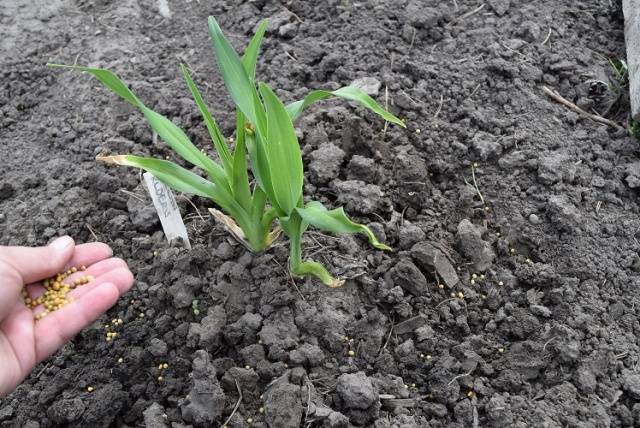
You need to feed the plant carefully so that the granules do not fall on the root collar.
Watering and feeding
Daylily Frans Hals is a rather unpretentious plant. Its most important requirement is proper watering, especially during the flowering period. He loves moisture. If there is not enough of it, drought, the daylily will not bloom so beautifully. It is better to water daylilies less often, but more abundantly, so that moisture penetrates deep into the soil to the roots themselves. On summer days, it is better to do this in the evening, when the sun has already set and there is no heat.
Daylily Frans Hals needs to be fed as follows:
- make the first feeding immediately after the appearance of the first green shoots of the bush (1 tbsp. l. nitroammofoski / 1 bucket of water);
- the second - in April, a month later, the composition is the same, but slightly increase the amount of nitrogen so that the bush grows faster;
- the third - during budding, use an infusion of fermented mullein (1 liter of mullein / 1 liter of water) or fermented green mass (1 liter of green fertilizers / 1 bucket of water);
- the fourth - two weeks after the end of flowering, nitrogen can no longer be added, phosphorus-potassium fertilizers will be enough (1 table liter of phosphorus and 1 table liter of potassium / 1 bucket of water); instead of potassium, ash or Diammofoska can be used, top dressing is aimed at preparing the plant for winter.
When fertilizing a plant in the fall, you need to pay attention to the fact that the granules (phosphorus + potassium) do not fall into the center of the bush. In this case, the root collar will be damaged by the decomposed granule.

The fourth dressing before wintering should not contain nitrogen.
Daylily Pruning Frans Hals
With the onset of the first frost, the leaves of the bush are pruned at a height of 5-10 cm from the ground. This is preparation for winter. Old leaves can be removed in early spring, after hibernation. They have already served their service, warming the plant during the frosty period and preventing the soil from hypothermia.
Preparing for winter
Before the onset of winter, the plant must be mulched during the period when the ground under the bushes has cooled down, but has not yet had time to freeze. It makes no sense to do this too early, while the ground is still hot enough after a hot summer. The roots can grow moldy and rot. Mulching should be done not earlier than the beginning of November, but for different regions these periods may vary. For this, sawdust, straw are suitable.
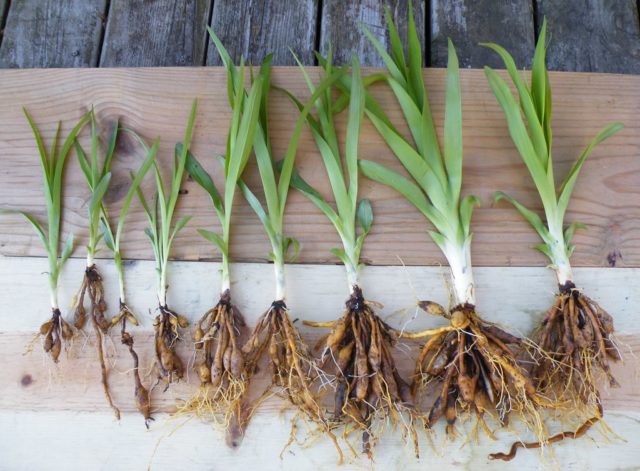
The mother bush can be divided into several daughter seedlings
Reproduction
To get a separate instance from the parent, you can use several methods. The first is the mechanical division of the bush. Can be carried out from early spring to mid-September. Cover the cut with ash or activated carbon powder. Plant the resulting seedlings in new places.
The second method is propagation by seeds collected from a ripe mother bush. It is used more often by breeders, scientists to develop new varieties. First, in greenhouse (home) conditions, sprouts are germinated, and then transplanted into the ground.
The third way is the proliferation or rooting of inflorescences. A leaf rosette is taken as a planting specimen. Pre-hold in water with growth stimulants until the first 5 cm long roots appear.
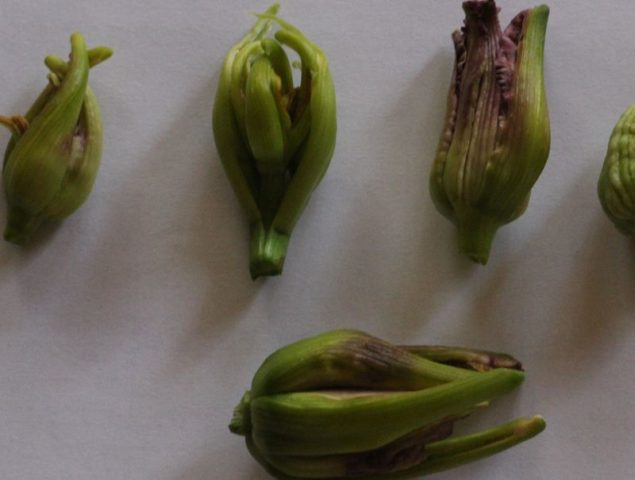
Buds affected by gall midges, the so-called daylily gnat, must be destroyed
Diseases and pests
This cheerful flower practically does not get sick. Its main problem is daylily midges that live in buds. Or worse, you can see a lot of worms. To get rid of them, it is enough to simply remove such a swollen bud.
Still others are frightened by the sudden yellowing of leaves on visually healthy bushes. Don't worry. In fact, this can be explained very simply. Leaves change. It is necessary to remove dried greens so that the look of the bush does not deteriorate. And the plant itself recovers.
Conclusion
Daylily Frans Hals can decorate any garden or lawn. He's bright, handsome and lovable.Will add a touch of joy and good mood, optimism. He likes to dominate in flower arrangements.
Reviews about daylily Frans Hals
